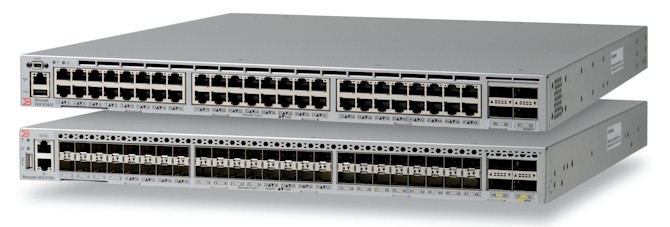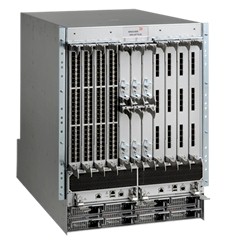Brocade Dials Bandwidth Up With Latest Ethernet Switches

With 10 Gb/sec Ethernet finally taking off in the data center, large enterprises now need more bandwidth on uplinks coming off their top-of-rack switches and into the core switches that constitute the network backbone. To tackle this, Brocade Communications has boosted its top-of-rack switches with 40 Gb/sec uplinks and is prepping a new line card for its modular switches that will be able to handle 100 Gb/sec.
The new switches are interesting in their own right, but Brocade's Virtual Fabric software, which glues an enormous number of switch ports and server virtual machines talking to them into a single management domain, are what gives Brocade a foot in the door at the largest data centers in the world. The vRouter software it got through its acquisition of Vyatta for an undisclosed sum last November doesn't hurt, either.
There are two new top of rack switches, and both are based on an ASIC that can deliver 1.28 Tb/sec of switching bandwidth and handle 960 million packets per second. The VDX 6740 has 48 SFP+ ports running at 10 Gb/sec with a port-to-port latency of 850 nanoseconds. This is pretty fast, but not the fastest, 10 Gb/sec switch out there. The VDX 6740 has four QSFP+ ports that can be used as uplinks that run at 40 Gb/sec; these uplinks can be aggregated into a 160 Gb/sec using Brocade's Inter-Switch Linking (ISL) software, which was originally created to aggregate bandwidth on its Fibre Channel switches to boost storage throughput. If you are not ready to use 40 Gb/sec uplinks yet, but are buying for the future day when you will, then you can use splitter cables and break the 40 Gb/sec ports into four 10 Gb/sec ports, for a total of 64 ports. The VDX 6740 is rated at 2 watts per 10 Gb/sec port and is therefore intended for high-density environments.
The second top-of-rack switch is the VDX 6740T, and it uses the cheaper 10BASE-T ports and cabling on the main 48 ports in the switch with the same four 40 Gb/sec uplinks using QSFP+ ports. A port-to-port hop takes 3 milliseconds on this latter machine, and it runs a little hotter at 5 watts per 10 Gb/sec port. You can use the same splitter cables to convert it into a 64-port switch, of course.
Interestingly, you can buy the switches with 24 through 64 ports activated, in 8-port blocks, in an on-demand fashion. Also, 32 of the ports on these two devices are Flex Ports, which means they can be set up to handle Ethernet server or Fibre Channel storage traffic as well as Fibre Channel over Ethernet (FCoE) if you want to do it the way Cisco wants you to.
These two switches support the OpenFlow 1.3 protocol, which is at the heart of many software-defined networking strategies these days. And the new boxes also support two new overlay protocols that extend Layer 2 networks so they can break through the 4,096 virtual LAN limit that caps their expansion today; this is necessary because large multitenant clouds, whether public or private, can easily exceed this limit. The overlays have a secondary function of stretching the Layer 2 switching over Layer 3 routing networks, which means virtual machines don't get lost as they jump across routers, perhaps linking different data centers together. With the overlays, it all looks like one big virtual Layer 2 network as far as the VMs are concerned. The Brocade switches support the VXLAN network virtualization protocol promoted by VMware as well as the NVGRE overlay, an alternative that Microsoft has been pushing along with Intel, Hewlett-Packard, and Dell.
Brocade says that pricing for these new switches starts at $15,995, and that is presumably the price for the VDX 6740T, which has higher latency, uses cheaper cabling, and runs hotter. The VDX 6740 should carry some kind of premium, given its lower latency and better energy efficiency.
The company also said that it was cooking up a 100 Gb/sec line card for its VDX 8770 modular switches, which are generally used are the core switch in a three-tier network. This card, which will be available in the first half of 2014, will have six ports on the line card. The VDX 8770 has eight line cards in its chassis and currently supports line cards running at 1 Gb/sec, 10 Gb/sec, or 40 Gb/sec. Pricing was not set since the product is not yet shipping.
Finally, Brocade is also showing off a new virtual router, the Vyatta 5600 vRouter, which is in limited availability now and which is expected to ship before 2013 comes to a close. The initial 5400 vRouter has been deployed as part of the virtual networking stack at the public clouds run by Amazon Web Services, Rackspace Hosting, and SoftLayer (now part of IBM). The 5600 vRouter will have more oomph, being able to drive up to 10 Gb/sec of traffic per core on an X86-based server. Brocade is bragging that this performance is 40 times better than the 250 Mb/sec of throughput that Cisco is showing with its CSR 1000v virtual router, which was launched in June 2012. The forthcoming 5600 vRouter is about 14 times faster than its 5400 vRouter predecessor, and if the PCI-Express bus on the servers was not saturated, Brocade says it could push it even faster.
Brocade is the dominant supplier of high-speed Fibre Channel switches that link servers to storage area networks, and many large enterprises have its gear installed. Just like Cisco Systems has leveraged its position in data center networking to sell systems to enterprise customers, Brocade is trying to leverage its position as a storage networking supplier to get a piece of the Ethernet switching racket. And like Cisco, Brocade believes in converged server and storage networking. Cisco has been the big driver behind this idea of running the Fibre Channel protocol over Ethernet, eliminating one kind of switch from the network. In fact, this idea is at the heart of its Unified Computing System machines, which virtualize and converge server and storage traffic in a top-of-rack switch embedded in the system.
Brocade didn't just sit there as Cisco and other server makers that were either building up their network businesses (or acquiring new ones) peddled server-storage convergence using the FCoE protocol on their switches. Brocade paid $3 billion to acquire Foundry Networks in the summer of 2008, just as Cisco was finishing up development of its UCS machine. Within a short time, Hewlett-Packard bought 3Com, Dell bought Force10 Networks, and IBM bought Blade Network Technology.
Brocade and Juniper Networks haven't launched their own converged systems, and there is no indication that either company is even remotely tempted to go down that road. Rather, they want to be perceived as neutral players for large enterprises that do not want the vendor lock in that comes with a converged system or even buying all of the parts from a single supplier and their tight partners.












